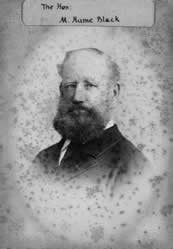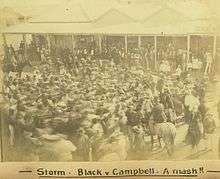Maurice Black (Australian politician)
| Maurice Black JP | |
|---|---|
 | |
| Member of the Queensland Legislative Assembly for Mackay | |
|
In office 24 March 1881 – 29 April 1893 Serving with David Dalrymple | |
| Preceded by | Francis Amhurst |
| Succeeded by | James Chataway |
| Personal details | |
| Born |
Maurice Hume Black 15 December 1835 London, England |
| Died |
16 August 1899 (aged 63) Coolgardie, Western Australia, Australia |
| Resting place | Coolgardie Cemetery |
| Nationality | English |
| Spouse(s) | Maria Frederica Davies (m.1861 d.1906) |
| Occupation | Gold miner, Farmer, Attorney |
| Religion | Church of England |
Maurice Hume Black (15 December 1835 – 16 August 1899) was an Australian politician, member of the Queensland Legislative Assembly[1]
Black was a grand-nephew of the celebrated Joseph Hume, Member for Montrose in the British House of Commons. He was born in London, England and in 1861 married Maria Frederica Davies, a niece of the great statesman, George Canning.[2]
Having emigrated to Victoria (Australia) in 1852, Black left the goldfields of that colony to try his luck in pastoral pursuits in South Australia, subsequently going to the Riverina, and in 1864 to Queensland. Black was the inventor of a steam sheep-washing process, and went into sugar planting in the Mackay district of Queensland in 1871.[2]

In 1881 Black was elected to the Legislative Assembly for the seat of Mackay.[3] Having taken a prominent part in the agitation for the separation of Northern Queensland from the rest of the colony, and its formation into a distinct colony, he was in 1887 commissioned to go to England with Mr. Lissner to press the matter upon the attention of the Home Government, Harold Finch-Hatton and Dr. Ahearne having done much to bring the matter into the region of practical politics by their exertions during the previous year.[2] Though not successful in inducing Lord Knutsford to take steps for the separation of Northern Queensland, the advanced phase which the question has since assumed is a good deal due to the efforts of the delegation of 1887. In June 1888, on the formation of the second Thomas McIlwraith Administration, Black became Secretary of Public Works, and continued to hold the post when five months later the Ministry was reconstructed under Boyd Dunlop Morehead. Black resigned with his colleagues in August 1890.[2]
Black left Parliament in April 1893[3][4] and worked as an immigration agent in the agent-general's office in London; this post was abolished in 1894.[1] Then Black decided to try his luck on the Coolgardie, Western Australia goldfields with some of his family; he arrived in 1896 and set up as an attorney for mining companies.
Black died in Coolgardie on 16 August 1899 of cirrhosis of the liver and cardiac failure[1] and was buried in the Coolgardie Cemetery.[5] His wife returned to Queensland and died in 1906.[6]
References
- 1 2 3 Bolton, G. C. "Black, Maurice Hume (1835–1899)". Australian Dictionary of Biography. Canberra: Australian National University. Retrieved 15 November 2013.
- 1 2 3 4 Mennell, Philip (1892). "
 Black, Maurice Hume". The Dictionary of Australasian Biography. London: Hutchinson & Co. Wikisource
Black, Maurice Hume". The Dictionary of Australasian Biography. London: Hutchinson & Co. Wikisource - 1 2 "Former Members". Parliament of Queensland. 2015. Retrieved 8 February 2015.
- ↑ "Alphabetical Register of Members of the Legislative Assembly 1860–2012" (PDF). Parliament of Queensland.
- ↑ Coolgardie Cemetery A-E – Outback family history. Retrieved 8 February 2015.
- ↑ "Family Notices.". The Brisbane Courier. National Library of Australia. 19 February 1906. p. 4. Retrieved 8 February 2015.
| Parliament of Queensland | ||
|---|---|---|
| Preceded by Francis Amhurst |
Member for Mackay 1881–1893 Served alongside: David Dalrymple |
Succeeded by James Chataway |
External links
- A Few Facts About Polynesian Labour In Queensland (1894) by M. Hume Black